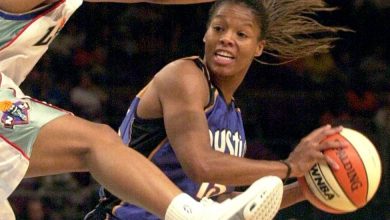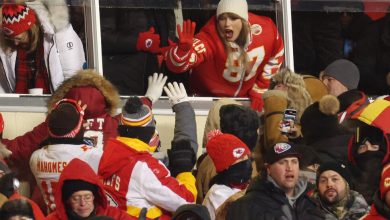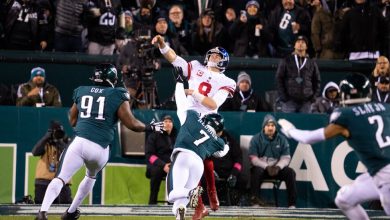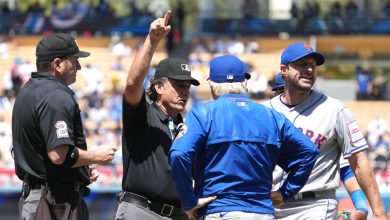A’s Will Finally Turn Out the Lights on Pro Sports in Oakland
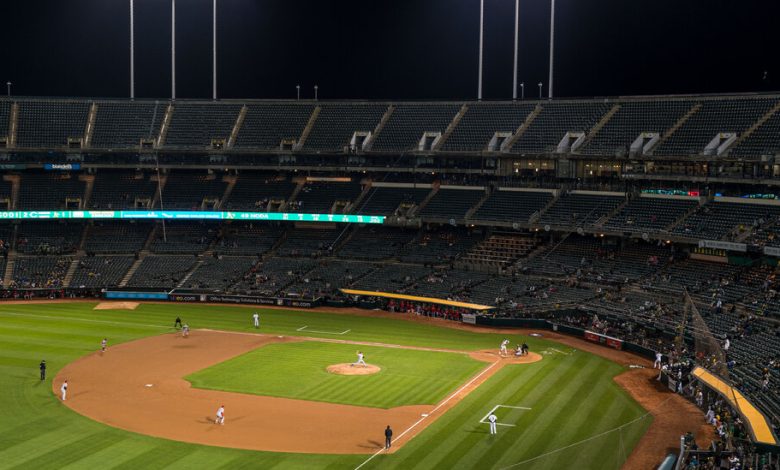
One by one, they have left Oakland.
First, the Warriors headed back across the bay to San Francisco in 2019, a return for a basketball franchise whose recent championship reign has been defined more by glitz than grit. Then, a year later, it was the itinerant Raiders heading to Las Vegas, the eye patch on their gridiron bandit logo obscuring an apparently wandering eye.
On Thursday, the final departure became all but official: Major League Baseball owners unanimously approved a move to Las Vegas by the Athletics, who not long ago used the marketing catch phrase “rooted in Oakland.”
There is still much for the ball club to sort out. The Athletics have another year on their lease in Oakland and their new stadium — a $1.5 billion, 30,000-seat ballpark with a retractable roof for which the Nevada Legislature approved public financing — won’t be ready until 2028. Where they will play in between is an open question. The Nevada teacher’s union is angling to put the subsidy on the ballot for voters.
But the A’s impending move, as inevitable as it has seemed, landed in Oakland like a fastball to the ribs.
“I don’t want this to sound hyperbolic, but for me it’s not only the death of the A’s, and of professional sports in the East Bay,” said Jim Zelinski, who more than a decade ago co-founded Save Oakland Sports, one of several groups that sprouted up over the years to keep teams from leaving the East Bay. “What this vote symbolizes for me is, this is really the death of the common, everyday fan.”
The working man has long been a central figure in American sports, attracted to the games as a diversion from the 9-to-5 grind and viewing them as a more level playing field than other societal arenas, the workplace among them.
As professional sports began to expand west in the late 1950s, Oakland — anchored by ship building, automobile manufacturing and its port — became an obvious landing spot.
Within little more than a decade, Oakland became home to the Raiders of the upstart American Football League, the Athletics, the Warriors and, briefly, the California Golden Seals of the National Hockey League, who for a time played in unfashionable white skates.
All the teams played at a complex centered on a vast asphalt lot, flanked by a major freeway and a rail line.
Soon, the lot will be vacant. This is not because Oakland has changed; it has largely retained a working-class ethos, albeit with California rents. Rather, the business calculus for teams has evolved.
Franchise revenue is now driven more by television deals and sponsorships than ticket sales, though those prices have skyrocketed. The transformation of sports into media products has relegated cities to backdrops and fans to props — a point that was driven home during the coronavirus pandemic when the games went on in vacant or mostly empty stadiums.
If it is baffling why the Athletics are leaving the Bay Area, which is the 10th biggest market, according to the Nielsen Company, for Las Vegas, which is the 40th largest market, there is another factor at play, according to Roger Noll, a Stanford sports economist emeritus.
Sports gambling.
As regional sports networks, a cash cow for sports teams, have begun to teeter — and in some cases collapse — Mr. Noll says sports gambling via streaming broadcasts is “the next golden goose” for sports franchises.
While Nevada has predictably welcomed internet gambling, California has not: Two measures, one of which was backed by M.L.B., were trounced last year in what was the country’s most expensive ballot campaign, with more than $450 million raised by both sides.
“If this is the next big thing, California sports teams are disadvantaged,” Mr. Noll said. “The old big-market, small-market dynamic is no longer going to favor the Bay Area and Los Angeles teams if a primary source of new revenue is unavailable to them.”
The Athletics have sought a new stadium for decades, under at least three different owners. They have tried to build a new ballpark south in Fremont and San Jose, downtown at Laney College or by the water at Howard Terminal, as well as at their current site.
Building new stadiums in California is its own contact sport, given the high cost of labor, stringent environmental standards and taxpayers’ aversion to subsidies for sports franchises. But it’s not impossible, as the Clippers’ new arena, scheduled to open next year in Inglewood, is the latest to demonstrate.
In Oakland, now may have been the most challenging time, thanks to a record $360 million budget deficit — and long memories of when the city lured the Raiders owner Al Davis back from Los Angeles in 1995 with a sweetheart loan deal that turned into a boondoggle for the city. Also, a towering bank of suites — christened Mount Davis — were built in the outfield, opening a revenue stream for the Raiders but closing off superb views of the Oakland Hills.
Over the years, the old Coliseum showed its age.
It had the concrete charm of a Soviet-era housing block, its plumbing regularly backed up — prompting a tweaking of the Raiders’ mantra to “Commitment to Excrement” — and the arrival of food trucks were a culinary life raft for fans who no longer had to settle for concession offerings that tasted distinctly like cardboard.
Still, the Athletics continued to be competitive, reinventing themselves by shrewdly using data to assess undervalued skills, a process that became known as “Moneyball,” after the best-selling book. The A’s have not reached the World Series since 1990, but they’ve been in the playoffs 11 times since 2000 — more than the Mets and the San Francisco Giants, and just as often as the Boston Red Sox.
Attendance had lingered in the lower third, though drum-pounding fans in right field causing a nightly ruckus added a degree of atmosphere. But when the team began its latest tear down, trading away its best players for prospects rather than paying their accelerating salaries, fans finally had enough of John Fisher, the owner, who before last season had raised ticket prices in what many sensed was a ploy to suppress attendance as a pretext for moving.
The A’s averaged 10,276 fans last season, the fewest in baseball. They finished 50-112, threatening for a while the record for futility set by the expansion Mets in 1962.
Fans who did turn up at the Coliseum often wore T-shirts or carried banners urging Mr. Fisher to sell the team.
Those who miss the Athletics most might be people like Matthias Haas.
He grew up a few miles from the Coliseum, steeped in the city’s rich baseball history that traces from Frank Robinson to Rickey Henderson to Dave Stewart to Jimmy Rollins, all of whom matriculated from Oakland sandlots to stardom in the big leagues. He learned the game’s finer points on the diamonds down the street at 66th and International in leagues that the Athletics helped bankroll. He has an enduring memory of sitting in the stands during the 2012 playoffs when the old mausoleum was rocking.
“There’s a certain pride in being an Oakland Athletics fan,” said Mr. Haas, who plays baseball at California Polytechnic State University, San Luis Obispo, plucking the adjectives “gritty” and “tough” to define his tribe. “People from Oakland say that they are from Oakland, not the Bay Area. That’s how it felt to be an A’s fan.”

